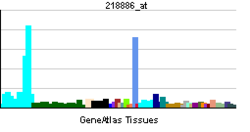- PAK1IP1
-
PAK1 interacting protein 1 Identifiers Symbols PAK1IP1; FLJ20624; MAK11; PIP1; RP11-421M1.5; WDR84; bA421M1.5; hPIP1 External IDs OMIM: 607811 MGI: 1915333 HomoloGene: 39574 GeneCards: PAK1IP1 Gene Gene Ontology Cellular component • nucleus
• nucleolus
• plasma membraneBiological process • negative regulation of signal transduction Sources: Amigo / QuickGO RNA expression pattern 
More reference expression data Orthologs Species Human Mouse Entrez 55003 68083 Ensembl ENSG00000111845 ENSMUSG00000038683 UniProt Q9NWT1 Q14AS0 RefSeq (mRNA) NM_017906 NM_026550.3 RefSeq (protein) NP_060376 NP_080826.2 Location (UCSC) Chr 6:
10.69 – 10.71 MbChr 13:
41.1 – 41.11 MbPubMed search [1] [2] p21-activated protein kinase-interacting protein 1 is an enzyme that in humans is encoded by the PAK1IP1 gene.[1][2]
Interactions
PAK1IP1 has been shown to interact with PAK1.[1]
References
- ^ a b Xia C, Ma W, Stafford LJ, Marcus S, Xiong WC, Liu M (May 2001). "Regulation of the p21-activated kinase (PAK) by a human Gbeta -like WD-repeat protein, hPIP1". Proc Natl Acad Sci U S A 98 (11): 6174–9. doi:10.1073/pnas.101137298. PMC 33441. PMID 11371639. http://www.pubmedcentral.nih.gov/articlerender.fcgi?tool=pmcentrez&artid=33441.
- ^ "Entrez Gene: PAK1IP1 PAK1 interacting protein 1". http://www.ncbi.nlm.nih.gov/sites/entrez?Db=gene&Cmd=ShowDetailView&TermToSearch=55003.
Further reading
- Maruyama K, Sugano S (1994). "Oligo-capping: a simple method to replace the cap structure of eukaryotic mRNAs with oligoribonucleotides.". Gene 138 (1–2): 171–4. doi:10.1016/0378-1119(94)90802-8. PMID 8125298.
- Suzuki Y, Yoshitomo-Nakagawa K, Maruyama K, et al. (1997). "Construction and characterization of a full length-enriched and a 5'-end-enriched cDNA library". Gene 200 (1–2): 149–56. doi:10.1016/S0378-1119(97)00411-3. PMID 9373149.
- Scherl A, Couté Y, Déon C, et al. (2003). "Functional proteomic analysis of human nucleolus". Mol. Biol. Cell 13 (11): 4100–9. doi:10.1091/mbc.E02-05-0271. PMC 133617. PMID 12429849. http://www.pubmedcentral.nih.gov/articlerender.fcgi?tool=pmcentrez&artid=133617.
- Strausberg RL, Feingold EA, Grouse LH, et al. (2003). "Generation and initial analysis of more than 15,000 full-length human and mouse cDNA sequences". Proc. Natl. Acad. Sci. U.S.A. 99 (26): 16899–903. doi:10.1073/pnas.242603899. PMC 139241. PMID 12477932. http://www.pubmedcentral.nih.gov/articlerender.fcgi?tool=pmcentrez&artid=139241.
- Mungall AJ, Palmer SA, Sims SK, et al. (2003). "The DNA sequence and analysis of human chromosome 6". Nature 425 (6960): 805–11. doi:10.1038/nature02055. PMID 14574404.
- Ota T, Suzuki Y, Nishikawa T, et al. (2004). "Complete sequencing and characterization of 21,243 full-length human cDNAs". Nat. Genet. 36 (1): 40–5. doi:10.1038/ng1285. PMID 14702039.
- Beausoleil SA, Jedrychowski M, Schwartz D, et al. (2004). "Large-scale characterization of HeLa cell nuclear phosphoproteins". Proc. Natl. Acad. Sci. U.S.A. 101 (33): 12130–5. doi:10.1073/pnas.0404720101. PMC 514446. PMID 15302935. http://www.pubmedcentral.nih.gov/articlerender.fcgi?tool=pmcentrez&artid=514446.
- Gerhard DS, Wagner L, Feingold EA, et al. (2004). "The status, quality, and expansion of the NIH full-length cDNA project: the Mammalian Gene Collection (MGC)". Genome Res. 14 (10B): 2121–7. doi:10.1101/gr.2596504. PMC 528928. PMID 15489334. http://www.pubmedcentral.nih.gov/articlerender.fcgi?tool=pmcentrez&artid=528928.
Categories:- Human proteins
- Chromosome 6 gene stubs
Wikimedia Foundation. 2010.
